Air-Purge Regenerative Direct Air Capture Using an Externally Heated and Cooled Temperature-Swing Adsorber Packed with Solid Amine
Abstract
1. Introduction
2. Experimental Methods
2.1. Adsorbent Packed Column
2.2. Breakthrough Curves of the Adsorbent
2.3. Experimental Apparatus and Conditions for Simple Adsorption–Desorption Cycle
2.4. Experimental Apparatus and Conditions for Double-Step Adsorption
2.5. Performance Indices
3. Results and Discussion
3.1. Influence of Half-Cycle Time on Performance of Simple Adsorption–Desorption Cycle
3.2. Effect of Extending Regeneration Time beyond Adsorption Time
3.3. Double-Step Adsorption
3.4. Influence of Cycle Operation on the Performance of Double-Step Adsorption
3.5. Influence of Regeneration Air Flow Rate
3.6. Influence of Feed Gas Flow Rate
4. Conclusions
- The adsorption step consumed a much shorter time than the desorption step, which indicated that the cycle operation was controlled by the latter. Shortening the cycle time greatly concentrated the CO2 at the desorption outlet, due to the rapid CO2 desorption rate, but the CO2 recovery ratio decreased significantly because the total amount of regeneration air per cycle time was much smaller than that of feed air. Hence, a trade-off existed between the regeneration outlet CO2 concentration and the CO2 recovery ratio.
- The proposed double-step adsorption process simultaneously improved CO2 adsorption and recovery. This method divided desorption gas over time, with high-CO2-concentration gas serving as the product gas and the remaining portion serving as the reflux feed gas to the adsorber. In this case, minimizing the adsorption/desorption time and prolonging the refluxing time significantly improved CO2 separation. Refluxing played a crucial role in enhancing CO2 capture because of the adsorption from high-CO2-concentration recirculation gas. Furthermore, a lower regeneration air flow rate during desorption increased the CO2 concentration.
Author Contributions
Funding
Data Availability Statement
Acknowledgments
Conflicts of Interest
References
- Houghton, J.T. Intergovernmental Panel on Climate Change. In Climate Change 2001: The Scientific Basis; Cambridge University Press: Cambridge, UK, 2001. [Google Scholar]
- Masson-Delmotte, V.; Zhai, P.; Pirani, A.; Connors, S.L.; Péan, C.; Berger, S.; Caud, N.; Chen, Y.; Goldfarb, L.; Gomis, M.I.; et al. Working Group I Contribution to the Sixth Assessment Report of the Intergovernmental Panel on Climate Change Edited by. 2021. Available online: www.ipcc.ch (accessed on 2 March 2022).
- Mac Dowell, N.; Fennell, P.; Shah, N.; Maitland, G.C. The role of CO2 capture and utilization in mitigating climate change. Nat. Clim. Chang. 2017, 7, 243–249. [Google Scholar] [CrossRef]
- Seipp, C.A.; Williams, N.J.; Kidder, M.K.; Custelcean, R. CO2 Capture from Ambient Air by Crystallization with a Guanidine Sorbent. Angew. Chem. 2016, 129, 1062–1065. [Google Scholar] [CrossRef]
- Joss, L.; Gazzani, M.; Mazzotti, M. Rational design of temperature swing adsorption cycles for post-combustion CO2 capture. Chem. Eng. Sci. 2016, 158, 381–394. [Google Scholar] [CrossRef]
- Bach, L.T.; Gill, S.J.; Rickaby, R.E.M.; Gore, S.; Renforth, P. CO2 Removal with Enhanced Weathering and Ocean Alkalinity Enhancement: Potential Risks and Co-benefits for Marine Pelagic Ecosystems. Front. Clim. 2019, 1, 7. [Google Scholar] [CrossRef]
- Smith, P.; Davis, S.J.; Creutzig, F.; Fuss, S.; Minx, J.; Gabrielle, B.; Kato, E.; Jackson, R.B.; Cowie, A.; Kriegler, E.; et al. Biophysical and economic limits to negative CO2 emissions. Nat. Clim. Chang. 2015, 6, 42–50. [Google Scholar] [CrossRef]
- Varghese, A.M.; Karanikolos, G.N. CO2 capture adsorbents functionalized by amine—Bearing polymers: A review. Int. J. Greenh. Gas Control. 2020, 96, 103005. [Google Scholar] [CrossRef]
- Zhao, Q.; Wu, F.; Men, Y.; Fang, X.; Zhao, J.; Xiao, P.; Webley, P.A.; Grande, C.A. CO2 capture using a novel hybrid monolith (H-ZSM5/activated carbon) as adsorbent by combined vacuum and electric swing adsorption (VESA). Chem. Eng. J. 2019, 358, 707–717. [Google Scholar] [CrossRef]
- Jiang, N.; Shen, Y.; Liu, B.; Zhang, D.; Tang, Z.; Li, G.; Fu, B. CO2 capture from dry flue gas by means of VPSA, TSA and TVSA. J. CO2 Util. 2019, 35, 153–168. [Google Scholar] [CrossRef]
- Hoysall, D.C.; Determan, M.D.; Garimella, S.; Lenz, R.D.; Leta, D.P. Optimization of Carbon Dioxide Capture Using Sorbent-Loaded Hollow-Fiber Modules. Int. J. Greenh. Gas Control. 2018, 76, 225–235. [Google Scholar] [CrossRef]
- Zainol, N.I.; Osaka, Y.; Tsujiguchi, T.; Kumita, M.; Kodama, A. Separation and enrichment of CH4 and CO2 from a dry biogas using a thermally regenerative adsorbent-packed heat exchanger. Adsorption 2019, 25, 1159–1167. [Google Scholar] [CrossRef]
- Rezaei, F.; Subramanian, S.; Kalyanaraman, J.; Lively, R.P.; Kawajiri, Y.; Realff, M.J. Modeling of rapid temperature swing adsorption using hollow fiber sorbents. Chem. Eng. Sci. 2014, 113, 62–76. [Google Scholar] [CrossRef]
- Masuda, S.; Osaka, Y.; Tsujiguchi, T.; Kodama, A. Carbon dioxide recovery from a simulated dry exhaust gas by an internally heated and cooled temperature swing adsorption packed with a typical hydrophobic adsorbent. Sep. Purif. Technol. 2021, 284, 120249. [Google Scholar] [CrossRef]
- Ntiamoah, A.; Ling, J.; Xiao, P.; Webley, P.A.; Zhai, Y. CO2 capture by temperature swing adsorption: Use of hot CO2-rich gas for regeneration. Ind. Eng. Chem. Res. 2016, 55, 703–713. [Google Scholar] [CrossRef]
- Masuda, S.; Osaka, Y.; Tsujiguchi, T.; Kodama, A. High-purity CO2 recovery following two-stage temperature swing adsorption using an internally heated and cooled adsorber. Sep. Purif. Technol. 2023, 309, 123062. [Google Scholar] [CrossRef]
- Sinha, A.; Darunte, L.A.; Jones, C.W.; Realff, M.J.; Kawajiri, Y. Systems Design and Economic Analysis of Direct Air Capture of CO2 through Temperature Vacuum Swing Adsorption Using MIL-101(Cr)-PEI-800 and mmen-Mg2(dobpdc) MOF Adsorbents. Ind. Eng. Chem. Res. 2017, 56, 750–764. [Google Scholar] [CrossRef]
- Stampi-Bombelli, V.; van der Spek, M.; Mazzotti, M. Analysis of direct capture of CO2 from ambient air via steam-assisted temperature–vacuum swing adsorption. Adsorption 2020, 26, 1183–1197. [Google Scholar] [CrossRef]
- Fujiki, J.; Chowdhury, F.A.; Yamada, H.; Yogo, K. Highly efficient post-combustion CO2 capture by low-temperature steam-aided vacuum swing adsorption using a novel polyamine-based solid sorbent. Chem. Eng. J. 2017, 307, 273–282. [Google Scholar] [CrossRef]
- Goeppert, A.; Czaun, M.; May, R.B.; Prakash, G.K.S.; Olah, G.A.; Narayanan, S.R. Carbon Dioxide Capture from the Air Using a Polyamine Based Regenerable Solid Adsorbent. J. Am. Chem. Soc. 2011, 133, 20164–20167. [Google Scholar] [CrossRef] [PubMed]
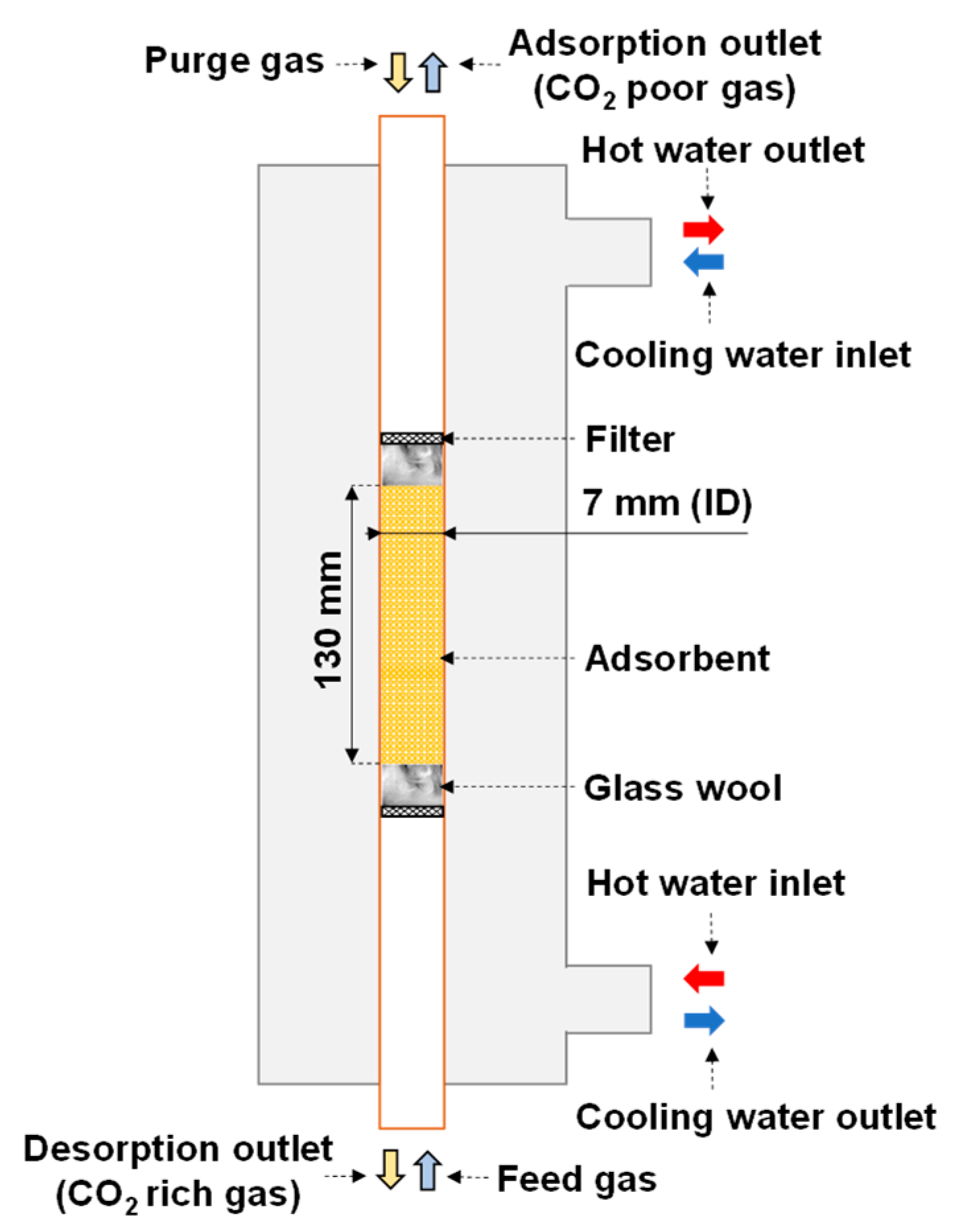
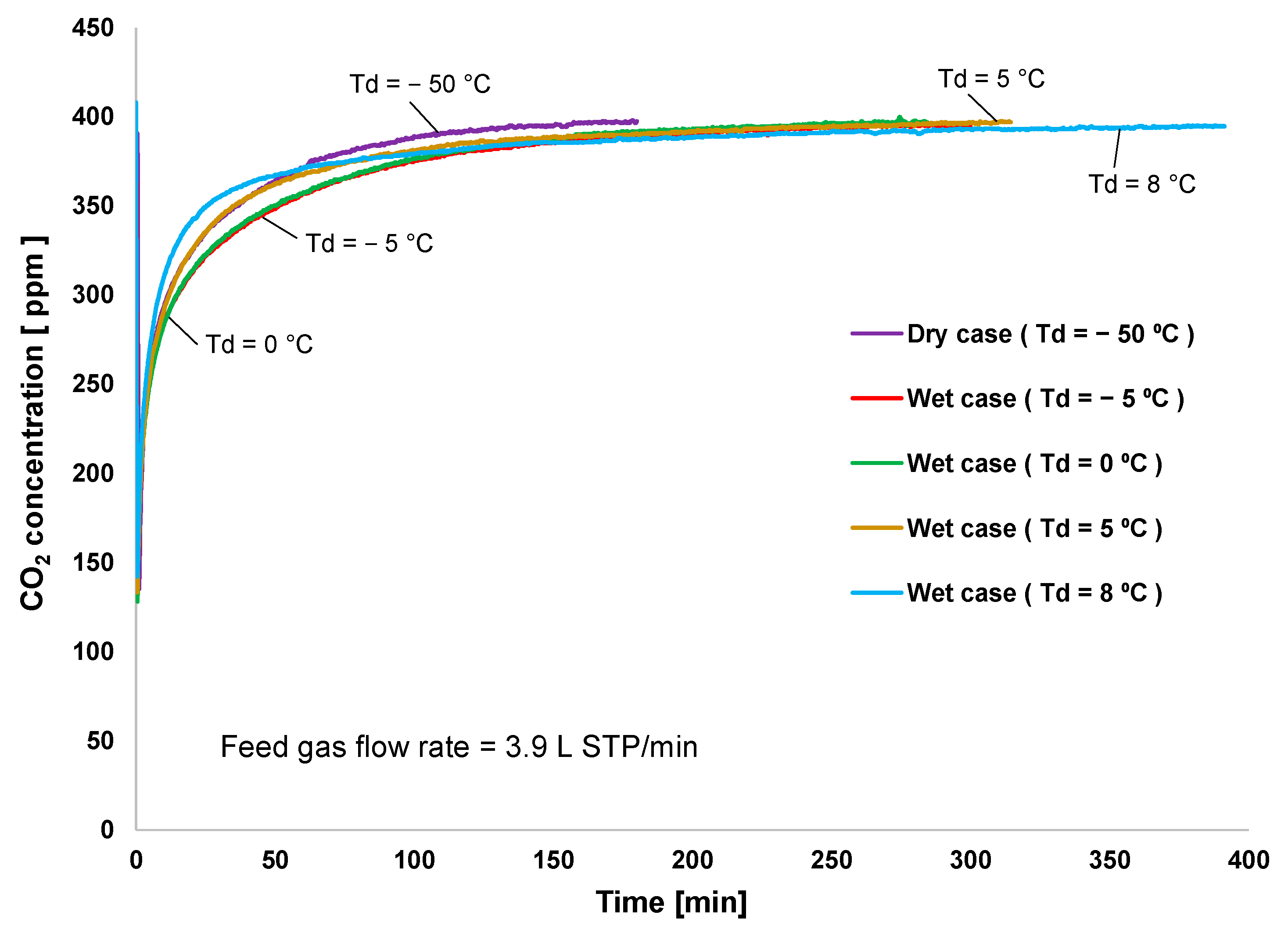
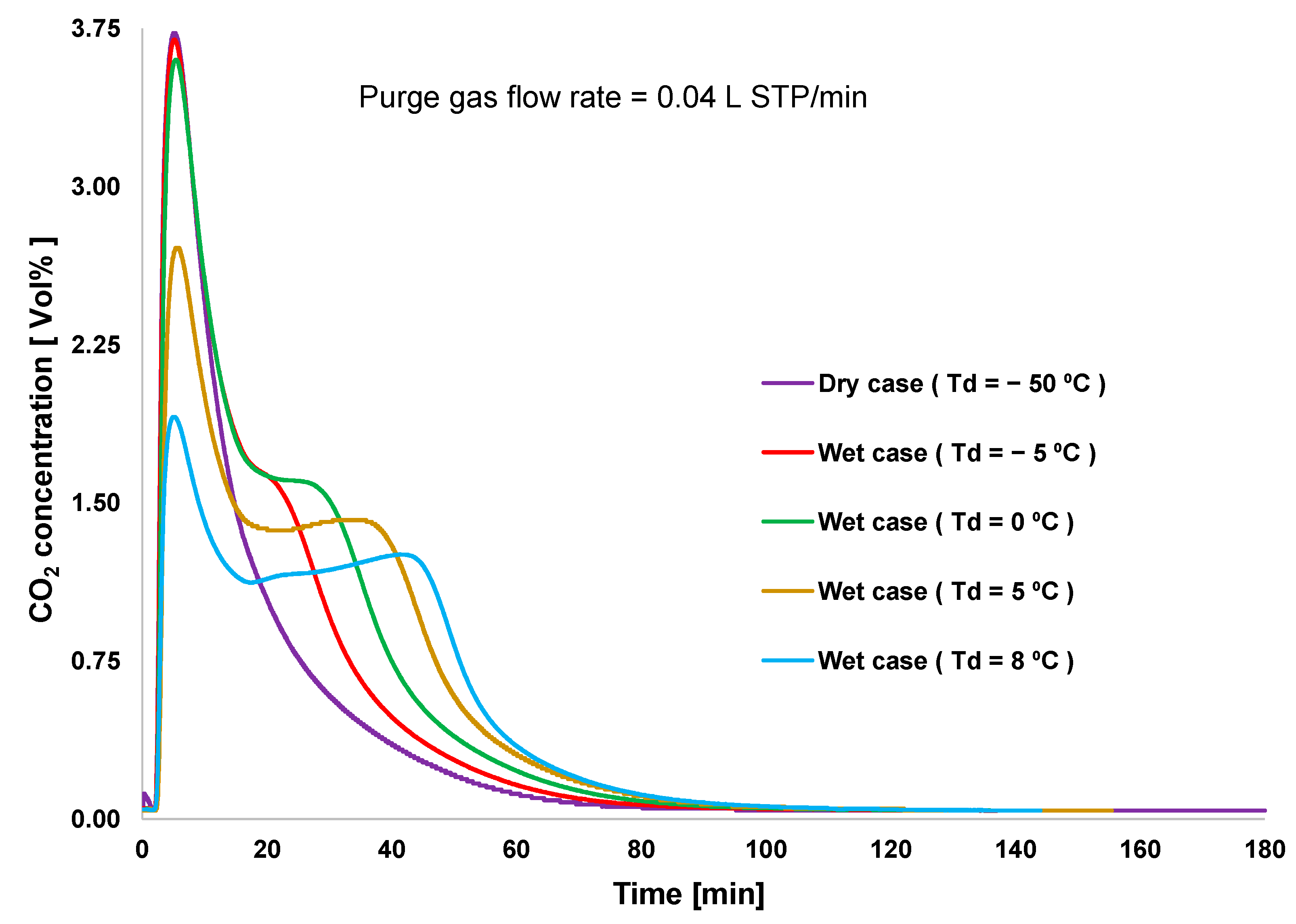
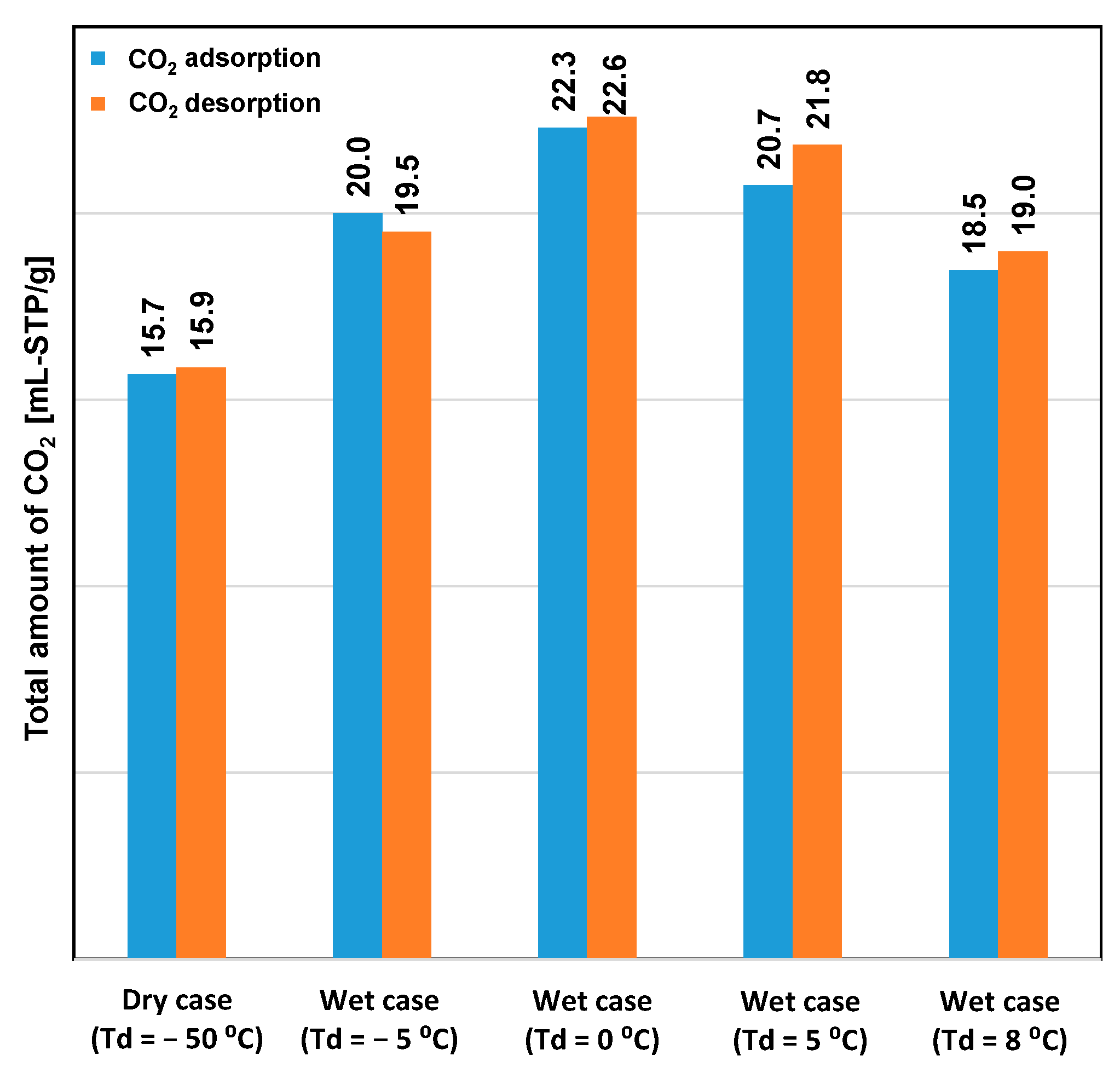
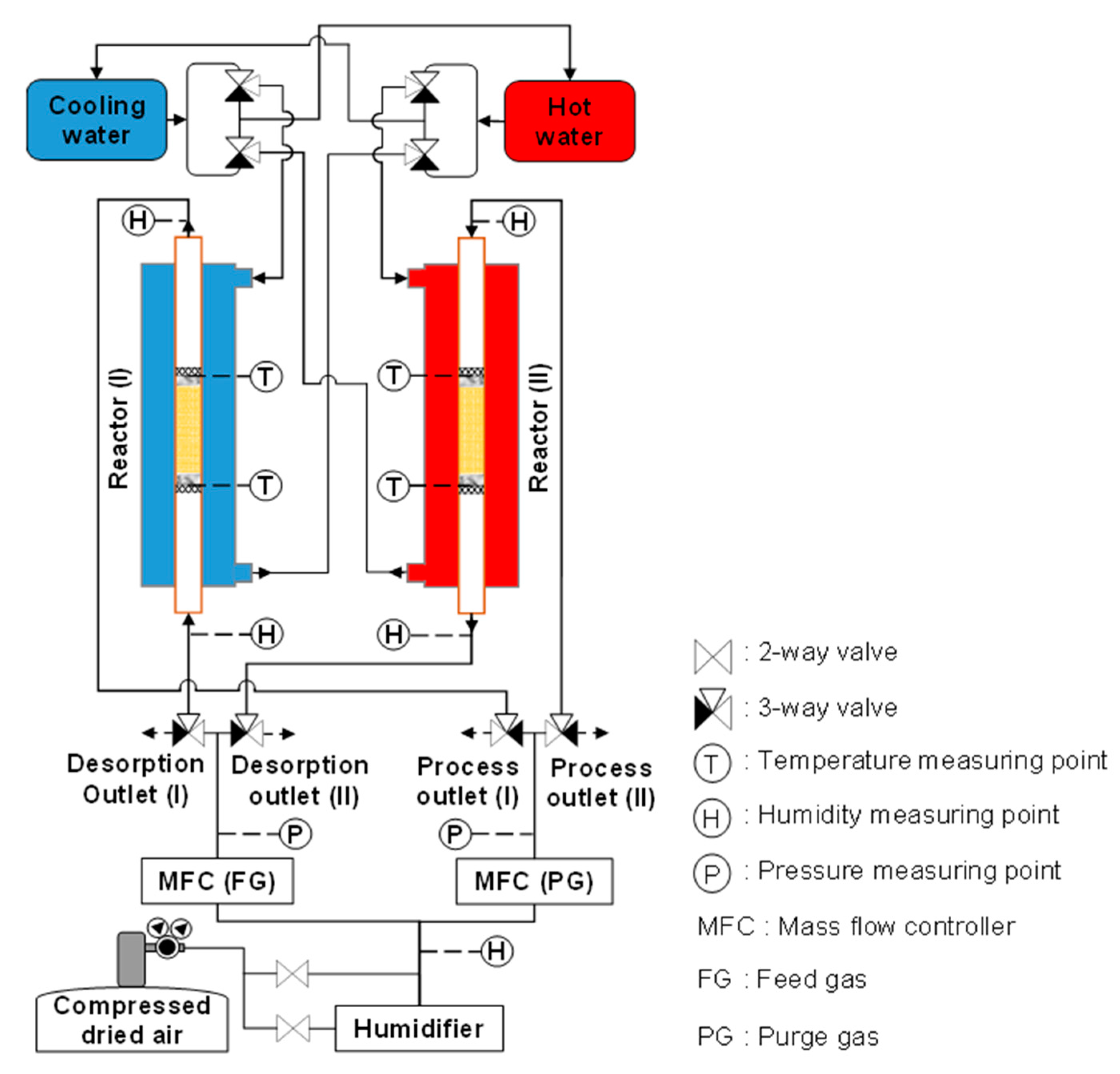
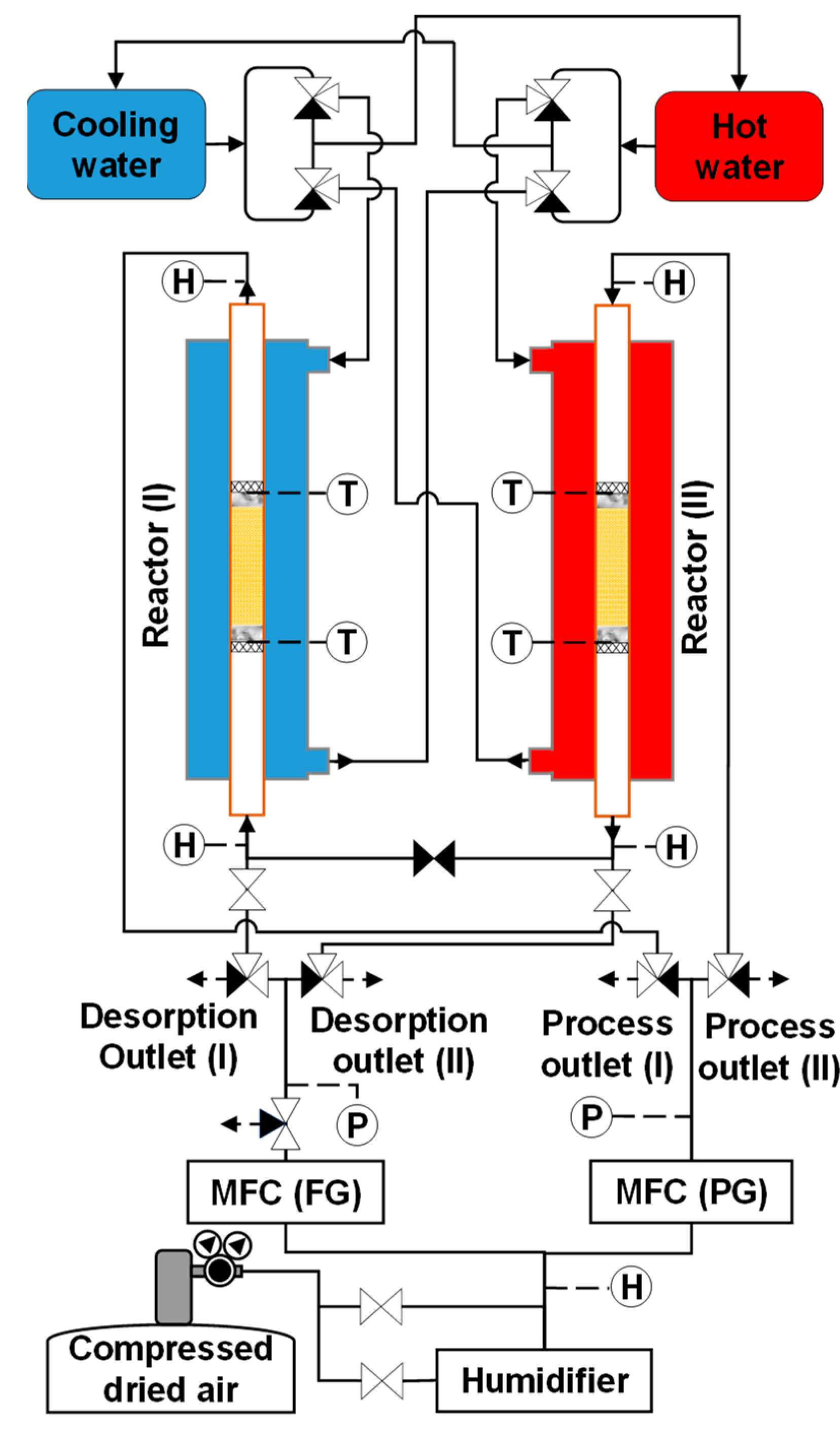
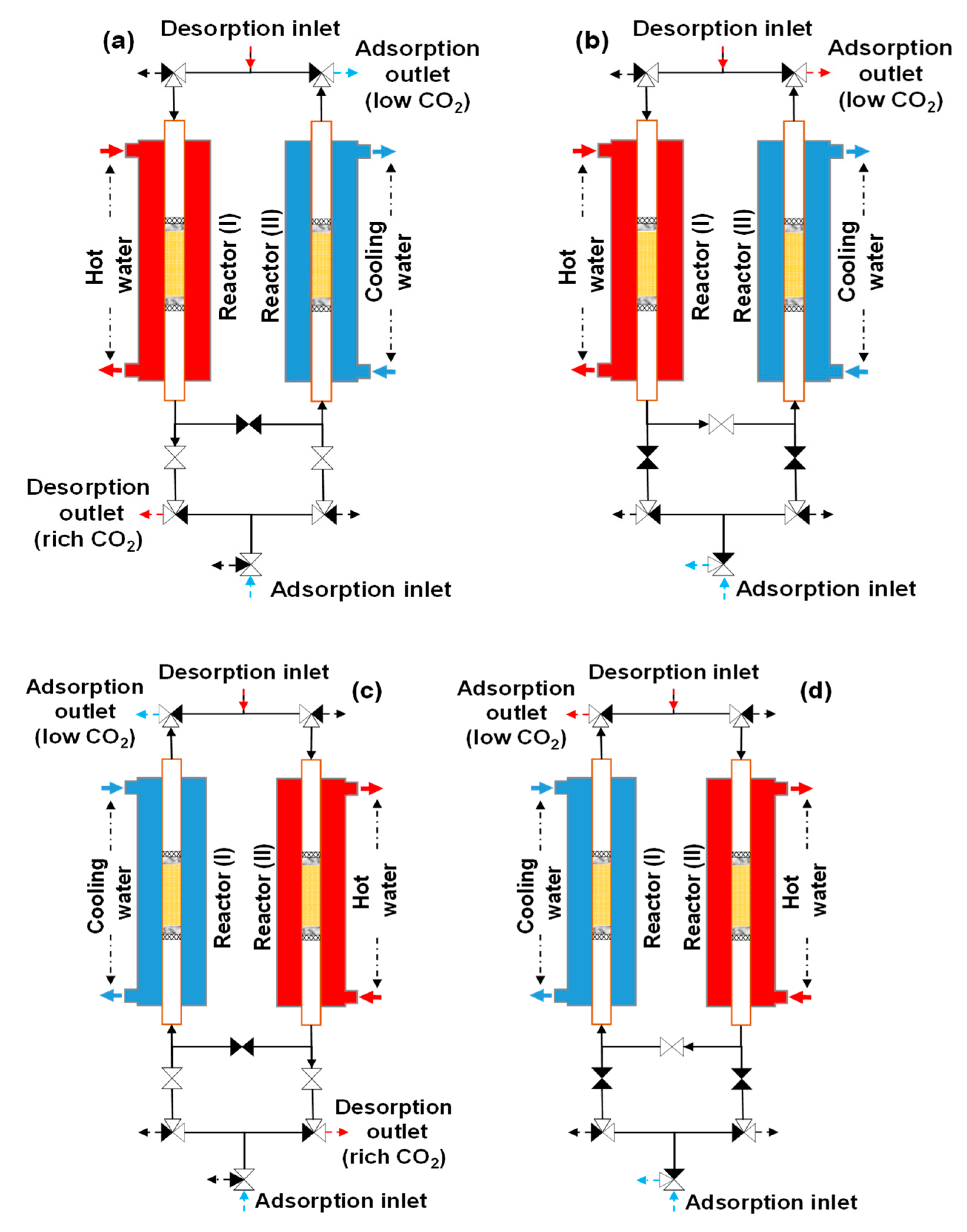
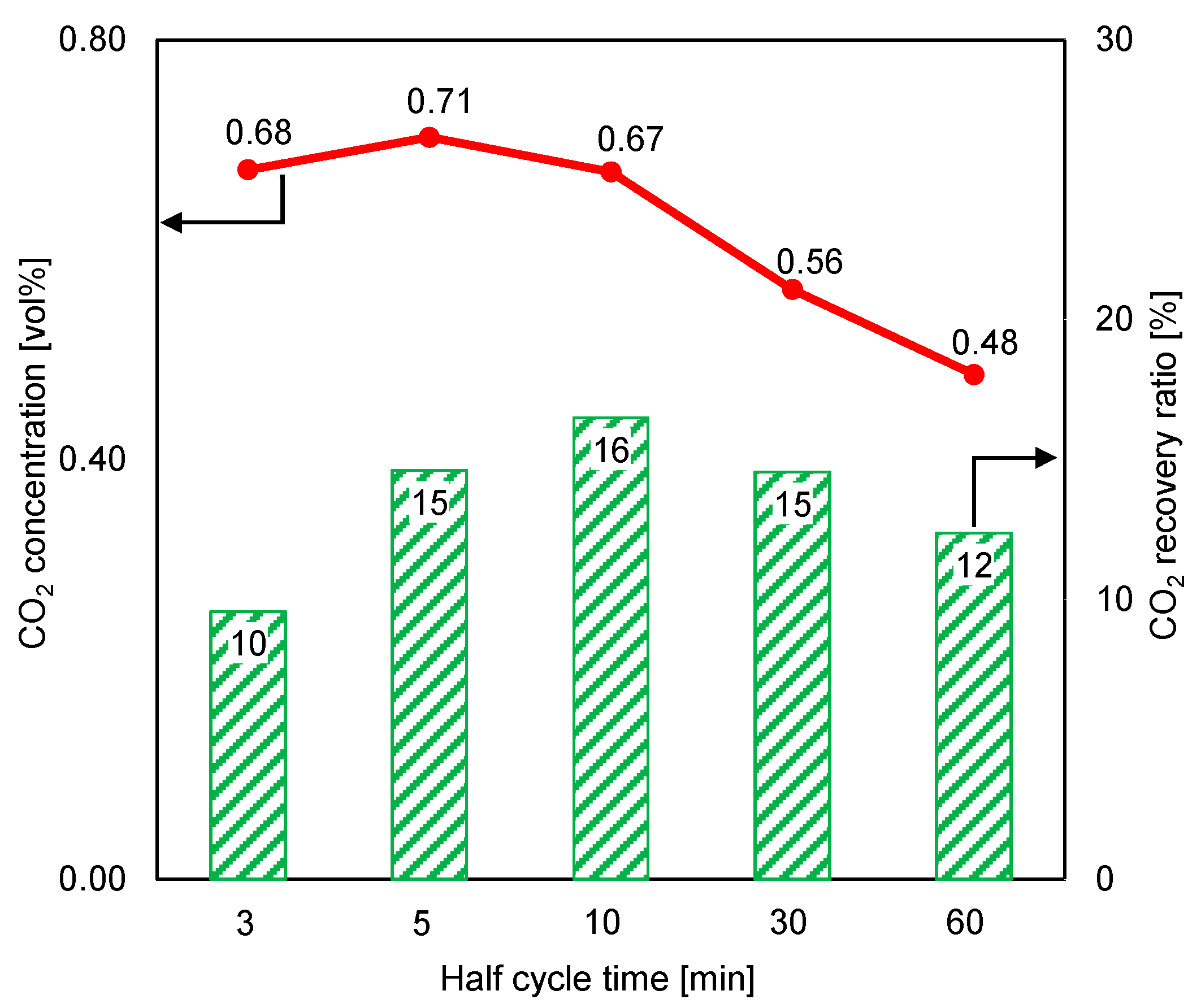
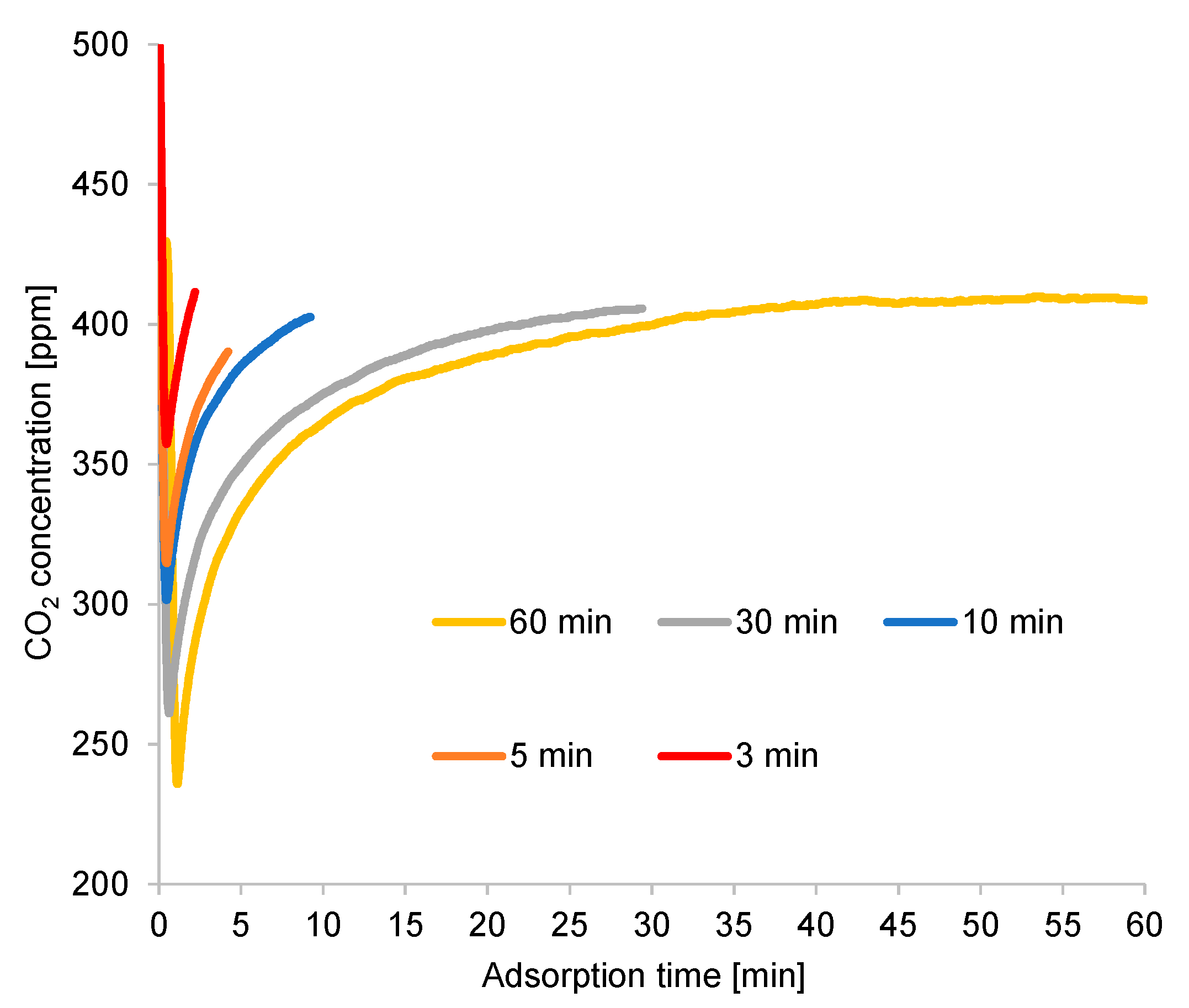
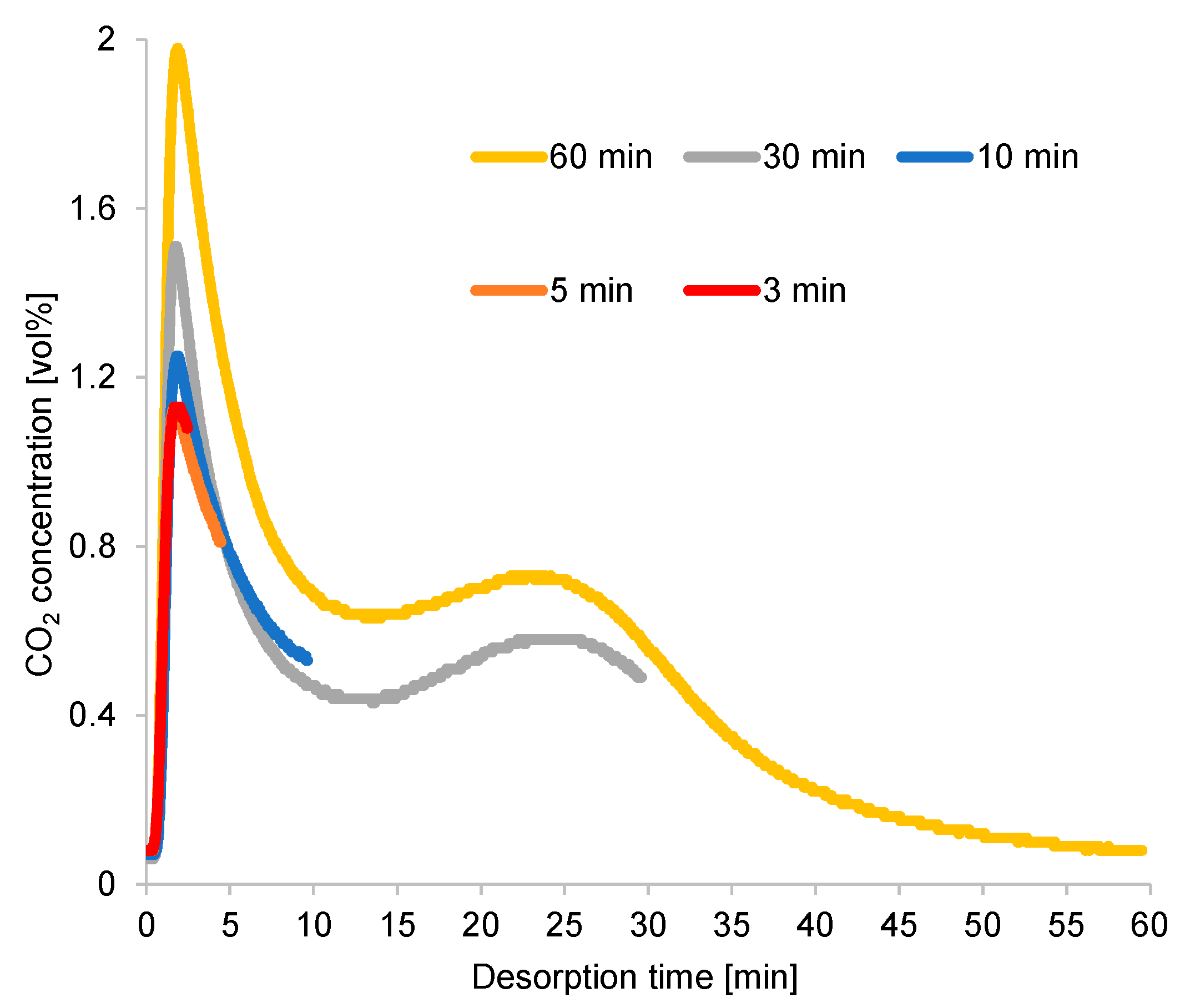
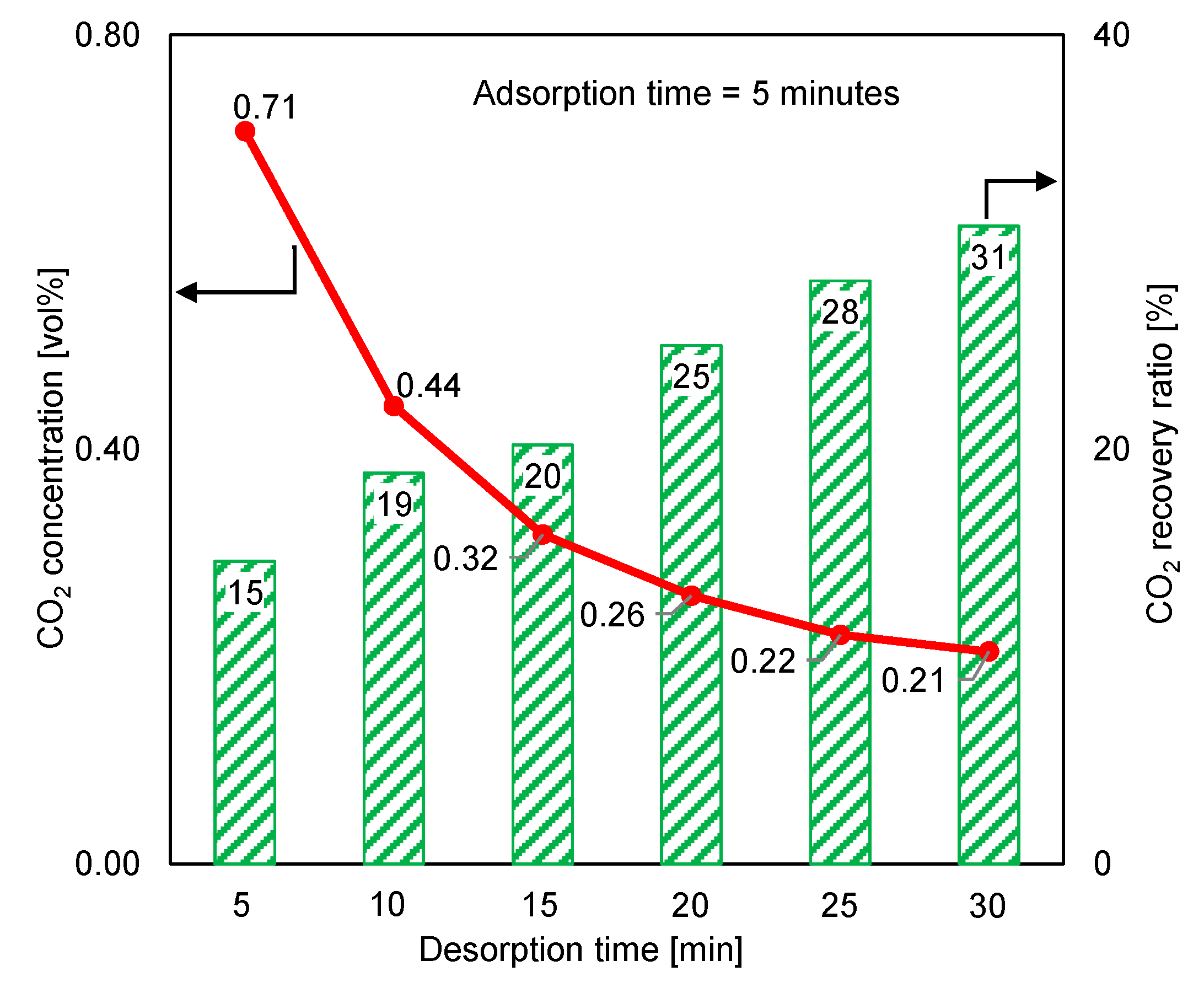




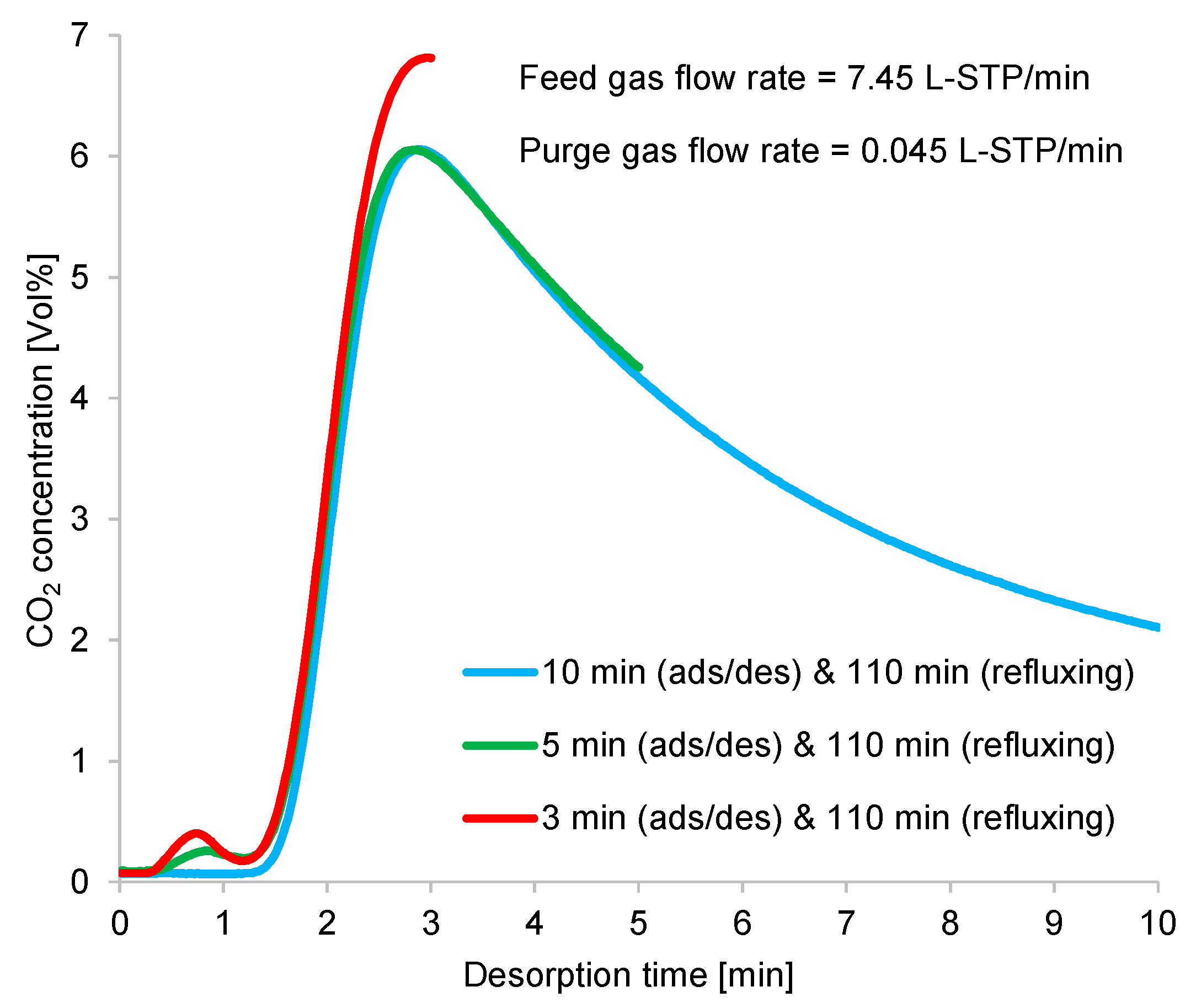
| RUN# | Step |
Temperature (°C) |
Air Flow Rate (L STP/min) |
Air Humidity Dew Point (°C) |
Time (min) |
|---|---|---|---|---|---|
| 1 | Adsorption Desorption | 20 60 | 9.3 0.09 | 5 | 3 3 |
| 2 | Adsorption Desorption | 20 60 | 9.3 0.09 | 5 | 5 5 |
| 3 | Adsorption Desorption | 20 60 | 9.3 0.09 | 5 | 10 10 |
| 4 | Adsorption Desorption | 20 60 | 9.3 0.09 | 5 | 30 30 |
| 5 | Adsorption Desorption | 20 60 | 9.3 0.09 | 5 | 60 60 |
| 6 | Adsorption Desorption | 20 60 | 9.3 0.09 | 5 | 5 10 |
| 7 | Adsorption Desorption | 20 60 | 9.3 0.09 | 5 | 5 15 |
| 8 | Adsorption Desorption | 20 60 | 9.3 0.09 | 5 | 5 20 |
| 9 | Adsorption Desorption | 20 60 | 9.3 0.09 | 5 | 5 25 |
| 10 | Adsorption Desorption | 20 60 | 9.3 0.09 | 5 | 5 30 |
| RUN# | Step |
Temperature ( °C ) |
Air Flow Rate (L STP/min) |
Air Humidity Dew Point ( °C ) |
Time (min) |
|---|---|---|---|---|---|
| 11-1 | Adsorption Desorption Refluxing | 20 60 60 & 20 | 9.3 0.09 0.09 | 5 | 3 3 3 |
| 11-2 | Adsorption Desorption Refluxing | 20 60 60 & 20 | 9.3 0.09 0.09 | 5 | 3 3 30 |
| 11-3 | Adsorption Desorption Refluxing | 20 60 60 & 20 | 9.3 0.09 0.09 | 5 | 3 3 55 |
| 11-4 | Adsorption Desorption Refluxing | 20 60 60 & 20 | 9.3 0.09 0.09 | 5 | 3 3 110 |
| 12-1 | Adsorption Desorption Refluxing | 20 60 60 & 20 | 9.3 0.09 0.09 | 5 | 5 5 5 |
| 12-2 | Adsorption Desorption Refluxing | 20 60 60 & 20 | 9.3 0.09 0.09 | 5 | 5 5 30 |
| 12-3 | Adsorption Desorption Refluxing | 20 60 60 & 20 | 9.3 0.09 0.09 | 5 | 5 5 55 |
| 12-4 | Adsorption Desorption Refluxing | 20 60 60 & 20 | 9.3 0.09 0.09 | 5 | 5 5 110 |
| 13-1 | Adsorption Desorption Refluxing | 20 60 60 & 20 | 9.3 0.09 0.09 | 5 | 10 10 10 |
| 13-2 | Adsorption Desorption Refluxing | 20 60 60 & 20 | 9.3 0.09 0.09 | 5 | 10 10 30 |
| 13-3 | Adsorption Desorption Refluxing | 20 60 60 & 20 | 9.3 0.09 0.09 | 5 | 10 10 55 |
| 13-4 | Adsorption Desorption Refluxing | 20 60 60 & 20 | 9.3 0.09 0.09 | 5 | 10 10 110 |
| 14-1 | Adsorption Desorption Refluxing | 20 60 60 & 20 | 9.3 0.045 0.045 | 5 | 3 3 3 |
| 14-2 | Adsorption Desorption Refluxing | 20 60 60 & 20 | 9.3 0.045 0.045 | 5 | 3 3 30 |
| 14-3 | Adsorption Desorption Refluxing | 20 60 60 & 20 | 9.3 0.045 0.045 | 5 | 3 3 55 |
| 14-4 | Adsorption Desorption Refluxing | 20 60 60 & 20 | 9.3 0.045 0.045 | 5 | 3 3 110 |
| 15-1 | Adsorption Desorption Refluxing | 20 60 60 & 20 | 9.3 0.045 0.045 | 5 | 5 5 5 |
| 15-2 | Adsorption Desorption Refluxing | 20 60 60 & 20 | 9.3 0.045 0.045 | 5 | 5 5 30 |
| 15-3 | Adsorption Desorption Refluxing | 20 60 60 & 20 | 9.3 0.045 0.045 | 5 | 5 5 55 |
| 15-4 | Adsorption Desorption Refluxing | 20 60 60 & 20 | 9.3 0.045 0.045 | 5 | 5 5 110 |
| 16-1 | Adsorption Desorption Refluxing | 20 60 60 & 20 | 9.3 0.045 0.045 | 5 | 10 10 10 |
| 16-2 | Adsorption Desorption Refluxing | 20 60 60 & 20 | 9.3 0.045 0.045 | 5 | 10 10 30 |
| 16-3 | Adsorption Desorption Refluxing | 20 60 60 & 20 | 9.3 0.045 0.045 | 5 | 10 10 55 |
| 16-4 | Adsorption Desorption Refluxing | 20 60 60 & 20 | 9.3 0.045 0.045 | 5 | 10 10 110 |
| 17-1 | Adsorption Desorption Refluxing | 20 60 60 & 20 | 7.45 0.045 0.045 | 5 | 3 3 3 |
| 17-2 | Adsorption Desorption Refluxing | 20 60 60 & 20 | 7.45 0.045 0.045 | 5 | 3 3 30 |
| 17-3 | Adsorption Desorption Refluxing | 20 60 60 & 20 | 7.45 0.045 0.045 | 5 | 3 3 55 |
| 17-4 | Adsorption Desorption Refluxing | 20 60 60 & 20 | 7.45 0.045 0.045 | 5 | 3 3 110 |
| 18-1 | Adsorption Desorption Refluxing | 20 60 60 & 20 | 7.45 0.045 0.045 | 5 | 5 5 5 |
| 18-2 | Adsorption Desorption Refluxing | 20 60 60 & 20 | 7.45 0.045 0.045 | 5 | 5 5 30 |
| 18-3 | Adsorption Desorption Refluxing | 20 60 60 & 20 | 7.45 0.045 0.045 | 5 | 5 5 55 |
| 18-4 | Adsorption Desorption Refluxing | 20 60 60 & 20 | 7.45 0.045 0.045 | 5 | 5 5 110 |
| 19-1 | Adsorption Desorption Refluxing | 20 60 60 & 20 | 7.45 0.045 0.045 | 5 | 10 10 10 |
| 19-2 | Adsorption Desorption Refluxing | 20 60 60 & 20 | 7.45 0.045 0.045 | 5 | 10 10 30 |
| 19-3 | Adsorption Desorption Refluxing | 20 60 60 & 20 | 7.45 0.045 0.045 | 5 | 10 10 55 |
| 19-4 | Adsorption Desorption Refluxing | 20 60 60 & 20 | 7.45 0.045 0.045 | 5 | 10 10 110 |
Disclaimer/Publisher’s Note: The statements, opinions and data contained in all publications are solely those of the individual author(s) and contributor(s) and not of MDPI and/or the editor(s). MDPI and/or the editor(s) disclaim responsibility for any injury to people or property resulting from any ideas, methods, instructions or products referred to in the content. |
© 2023 by the authors. Licensee MDPI, Basel, Switzerland. This article is an open access article distributed under the terms and conditions of the Creative Commons Attribution (CC BY) license (https://creativecommons.org/licenses/by/4.0/).
Share and Cite
Vannak, H.; Osaka, Y.; Tsujiguchi, T.; Kodama, A. Air-Purge Regenerative Direct Air Capture Using an Externally Heated and Cooled Temperature-Swing Adsorber Packed with Solid Amine. Separations 2023, 10, 415. https://doi.org/10.3390/separations10070415
Vannak H, Osaka Y, Tsujiguchi T, Kodama A. Air-Purge Regenerative Direct Air Capture Using an Externally Heated and Cooled Temperature-Swing Adsorber Packed with Solid Amine. Separations. 2023; 10(7):415. https://doi.org/10.3390/separations10070415
Chicago/Turabian StyleVannak, Heak, Yugo Osaka, Takuya Tsujiguchi, and Akio Kodama. 2023. "Air-Purge Regenerative Direct Air Capture Using an Externally Heated and Cooled Temperature-Swing Adsorber Packed with Solid Amine" Separations 10, no. 7: 415. https://doi.org/10.3390/separations10070415
APA StyleVannak, H., Osaka, Y., Tsujiguchi, T., & Kodama, A. (2023). Air-Purge Regenerative Direct Air Capture Using an Externally Heated and Cooled Temperature-Swing Adsorber Packed with Solid Amine. Separations, 10(7), 415. https://doi.org/10.3390/separations10070415








